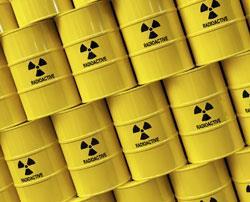The recent recommendations from the Committee on Radioactive Waste Management should prompt a renewed research effort to tackle the problems of nuclear waste storage.
After 30 months of deliberation, the Committee on radioactive waste management (CoRWM) published its final recommendations on the fate of the UK radioactive waste legacy on 31 July. Its call for ’a robust programme of interim storage’, followed by geological disposal in an underground repository, is consistent with the international consensus on nuclear waste disposal, supported by the International Atomic Energy Agency and the European commission.

The principle of repository disposal is to ensure containment of hazardous waste by multiple geological and engineered barriers, including the waste container, overpack and backfill materials. This strategy is considered suitable for disposing spent nuclear fuel, intermediate-level waste, and heat-generating high-level waste. Confidence in repository disposal is based on the demonstrable stability of the host geological formations, over hundreds of thousands of years, coupled with a slow movement of deep ground water.
Such environments afford greater protection to hazardous waste material against seismic or terrorist events, compared to surface storage facilities.
But selecting suitable disposal sites was not within CoRWM’s remit and must be given high priority by the organisation responsible for implementing the committee’s recommendations, given that the timescale of site identification, selection and investigation was estimated by the committee to be at least 30 years. More research is also required to investigate the durability of specific waste materials.
The CoRWM recommendations recognise that alternatives to repository disposal may be required for certain nuclear waste materials and highlight the need for supporting research and development to establish proof of concept. For example, separated plutonium that is surplus to fuel requirements would demand a proliferation-resistant disposal concept, such as very deep borehole disposal.
Robust interim storage of waste prior to repository disposal will be an important part of any national strategy based on the CoRWM recommendations. However, immobilisation of the wide range of unique legacy wastes in the UK, in a safe form suitable for storage, presents an exacting materials chemistry challenge. Urgent prioritisation and subsequent research in this area are now required to expedite future safe storage.
There can be no doubt that CoRWM has learnt the key lesson from five decades of international and UK experience: that a policy of ’decide, announce, defend’ cannot be used to impose a plan for long term management and disposal of nuclear wastes. Instead, CoRWM adopted a guiding principle of open and transparent decision making, to secure public confidence in its recommendations. The process of public consultation and engagement developed by CoRWM has been crucial in establishing a consensual strategy for the disposal of our nuclear waste. It is clear that continuity of this consultation process is essential for future community involvement in nuclear waste disposal.
The recommendations require the creation of an authoritative and independent organisation with a mission to develop and implement a national waste management and disposal strategy. However, this will lack credibility unless accompanied by appropriate investment in the skills base and research infrastructure required to address key uncertainties. The dilution of scientific input into the decision making process of CoRWM was the subject of substantial criticism by two members of the committee, who resigned part way through the process, and also drew flak from both the House of Lords select committee on science and technology, and the Royal Society. It is important to learn from this. The scientific membership of the organisation that implements this strategy must be given careful consideration, to ensure that the process is informed by reliable scientific and technical evidence. Public faith in geological disposal will not be assured by an open and transparent consultation process alone - we need a clear appraisal of the underpinning science. Only then can we be confident in putting our nuclear waste out of sight and out of mind.
Neil Hyatt is a lecturer in materials chemistry at the University of Sheffield, UK.
Francis Livens is Nexia Solutions professor of radiochemistry at the University of Manchester, UK.












No comments yet